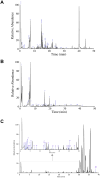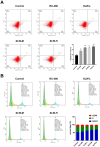Integrated pharmacoanalysis, bioinformatics analysis, and experimental validation to identify the ingredients and mechanisms of Xiao-Luo-Wan in uterine fibroids treatment
- PMID: 40219728
- PMCID: PMC11999358
- DOI: 10.1080/13880209.2025.2485905
Integrated pharmacoanalysis, bioinformatics analysis, and experimental validation to identify the ingredients and mechanisms of Xiao-Luo-Wan in uterine fibroids treatment
Abstract
Context: Xiao-Luo-Wan (XLW), a classical prescription in traditional Chinese medicine, has therapeutic effects on uterine fibroids (UFs). Herein, its anti-UF effects were examined using a systematic pharmacological method.
Objective: To explore the active ingredients of XLW via mass spectrometry and its potential effects on UFs by network pharmacology, molecular docking, and experimental validation.
Materials and methods: A mass spectrometer was used to scrutinize the composition of the XLW drug-containing serum. The critical targets and potential mechanisms of XLW against UFs were predicted by network pharmacology and molecular docking. Next, human uterine leiomyoma cells (UMCs) were treated with 20%, 30%, or 40% XLW serum for 24 h, 48 h or 72 h. Cell viability was analyzed via a CCK-8 assay, and cell apoptosis and the cell cycle were examined via flow cytometry. The predicted targets were further identified by RT-PCR and western blotting.
Results: There were 16 chemical components identified in XLW drug-containing serum, with 53 target genes predicated in the treatment of UFs. The molecular binding of core targets, including TRIM9, NF-κB and p38MAPK, was relatively stable to components, especially buergerinin B, cedrol and ent-15B-16-epoxy- kauan-17-ol. The in vitro experiments revealed that the IC50 of XLW in UMCs was 63.21%, and the anti-UF effects of XLW may be closely associated with targets that inhibit cell proliferation and promote cell apoptosis by regulating TRIM9, NF-κB and p38MAPK expression.
Discussion and conclusions: The integration of mass spectrometry, network pharmacology, molecular docking and biological experiments revealed the key constituents of XLW and its pharmacological mechanism in UFs, which may help in the discovery of therapeutic agents for treating UFs.
Keywords: Xiao-Luo-wan (XLW); human uterine leiomyoma cells; mass spectrometry; molecular docking; network pharmacology; uterine fibroids.
Conflict of interest statement
No potential conflict of interest was reported by the author(s).
Figures












References
MeSH terms
Substances
LinkOut - more resources
Full Text Sources
Other Literature Sources
Medical
Research Materials
Miscellaneous
